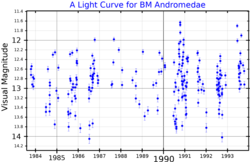
U Antliae is a variable star in the constellation Antlia. It is a carbon star surrounded by two thin shells of dust.

Phi Persei is a class B2Vep fourth-magnitude star in the constellation Perseus, location about 720 light-years from Earth.

HD 37974 a variable B[e] hypergiant in the Large Magellanic Cloud. It is surrounded by an unexpected dust disk.
HD 224801, also known as CG Andromedae, is an Alpha² Canum Venaticorum variable star in the constellation Andromeda. Located approximately 188 parsecs (610 ly) away, the star varies between apparent magnitudes 6.32 and 6.42 over a period of approximately 3.74 days.

WR 148 is a spectroscopic binary in the constellation Cygnus. The primary star is a Wolf–Rayet star and one of the most luminous stars known. The secondary has been suspected of being a stellar-mass black hole but may be a class O main sequence star.

IK Tauri or NML Tauri is a Mira variable star located about 280 parsecs (910 ly) from the Sun in the zodiac constellation of Taurus.

WR 9 is a spectroscopic binary in the constellation Puppis consisting of a Wolf-Rayet star and a class O star. It is around 12,000 light years away.
QV Andromedae is an Alpha2 Canum Venaticorum variable in the constellation Andromeda. Its maximum apparent visual magnitude is 6.6, so it can be seen by the naked eye under very favourable conditions. The brightness varies slightly following a periodic cycle of approximately 5.23 days.

AD Andromedae is an eclipsing binary in the constellation Andromeda. Its maximum apparent visual magnitude is 11.2, but it shows a decrease of 0.62 magnitudes during the main eclipse and 0.58 during the secondary one. It is classified as a Beta Lyrae variable star with a period of almost one day.
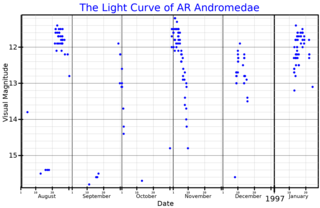
AR Andromedae is a dwarf nova of the SS Cygni type in the constellation Andromeda. Its typical apparent visual magnitude is 17.6, but increases up to 11.0 magnitude during outbursts. The outbursts occur approximately every 23 days.

CC Andromedae is a variable star in the constellation Andromeda. It is a pulsating star of the Delta Scuti type, with an apparent visual magnitude that varies between 9.19 and 9.46 with a periodicity of 3 hours.

EU Andromedae is a carbon star in the constellation Andromeda. Its apparent visual magnitude varies in an irregular manner between 10.7 and 11.8.
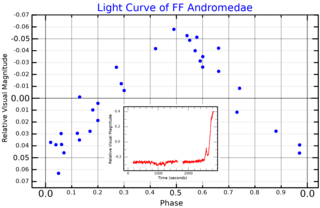
FF Andromedae is a spectroscopic binary in the constellation Andromeda. It has a typical apparent visual magnitude of 10.4, but undergoes flare events that can increase its brightness by about a magnitude.

GR Andromedae is a variable star in the constellation Andromeda. Its apparent visual magnitude varies between 6.87 and 6.95 in a cycle of 518.2 days. It is classified as an α2 Canum Venaticorum variable.

KX Andromedae is a spectroscopic binary star in the constellation Andromeda. Its apparent visual magnitude varies between 6.88 and 7.28.

LP Andromedae is a carbon star in the constellation Andromeda. It is also a Mira variable whose mean apparent visual magnitude is 15.12 and has pulsations with an amplitude of 1.50 magnitudes and a period of 614 days.
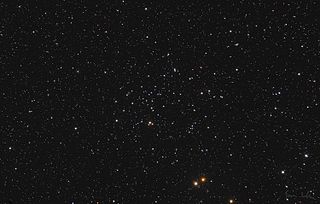
QX Andromedae is an eclipsing binary in the constellation Andromeda. It varies from a maximum apparent visual magnitude of 11.28 to a minimum of 11.50. Since it is impossible to specify the onset time of the eclipses, it is classified as a W Ursae Majoris variable star. It is also observed as an X-ray source and is a member of the open cluster NGC 752.
DH Tauri, also known as DH Tau, is a type M star, located 140 parsecs away. It forms a binary system with DI Tauri 15″ away, and has a substellar companion, either a brown dwarf or massive exoplanet.

WR 133 is a visually moderately bright Wolf-Rayet star. It is a spectroscopic binary system containing a Wolf-Rayet primary and a class O supergiant secondary. It is in the constellation of Cygnus, lying in the sky at the centre of the triangle formed by β and γ Cygni, near η Cygni. It is the brightest member of the sparse open cluster NGC 6871.
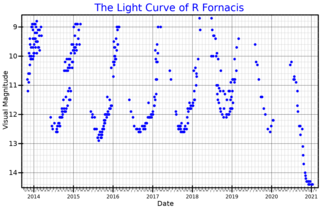
R Fornacis is a Mira variable and carbon star located in the constellation Fornax. It is around 1,800 light years away based on parallax measurements.
